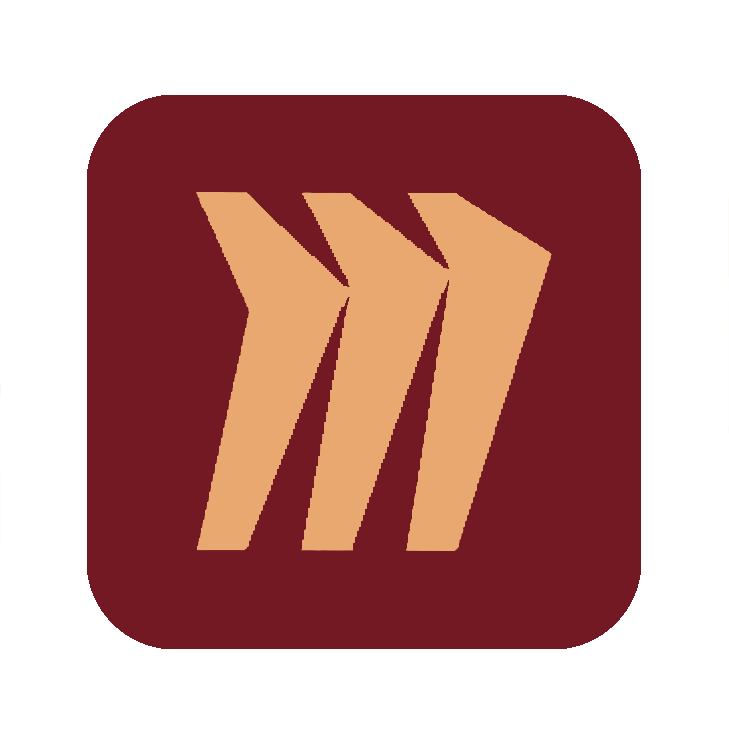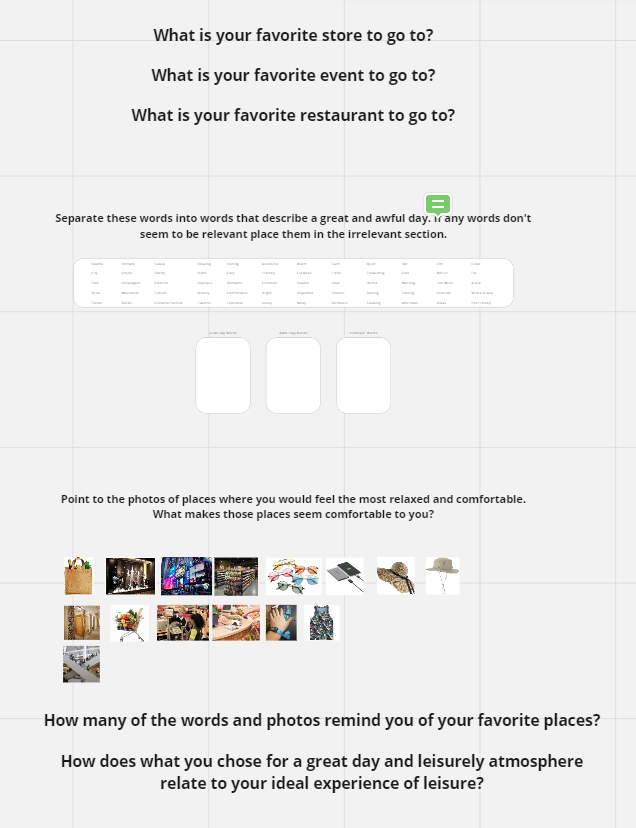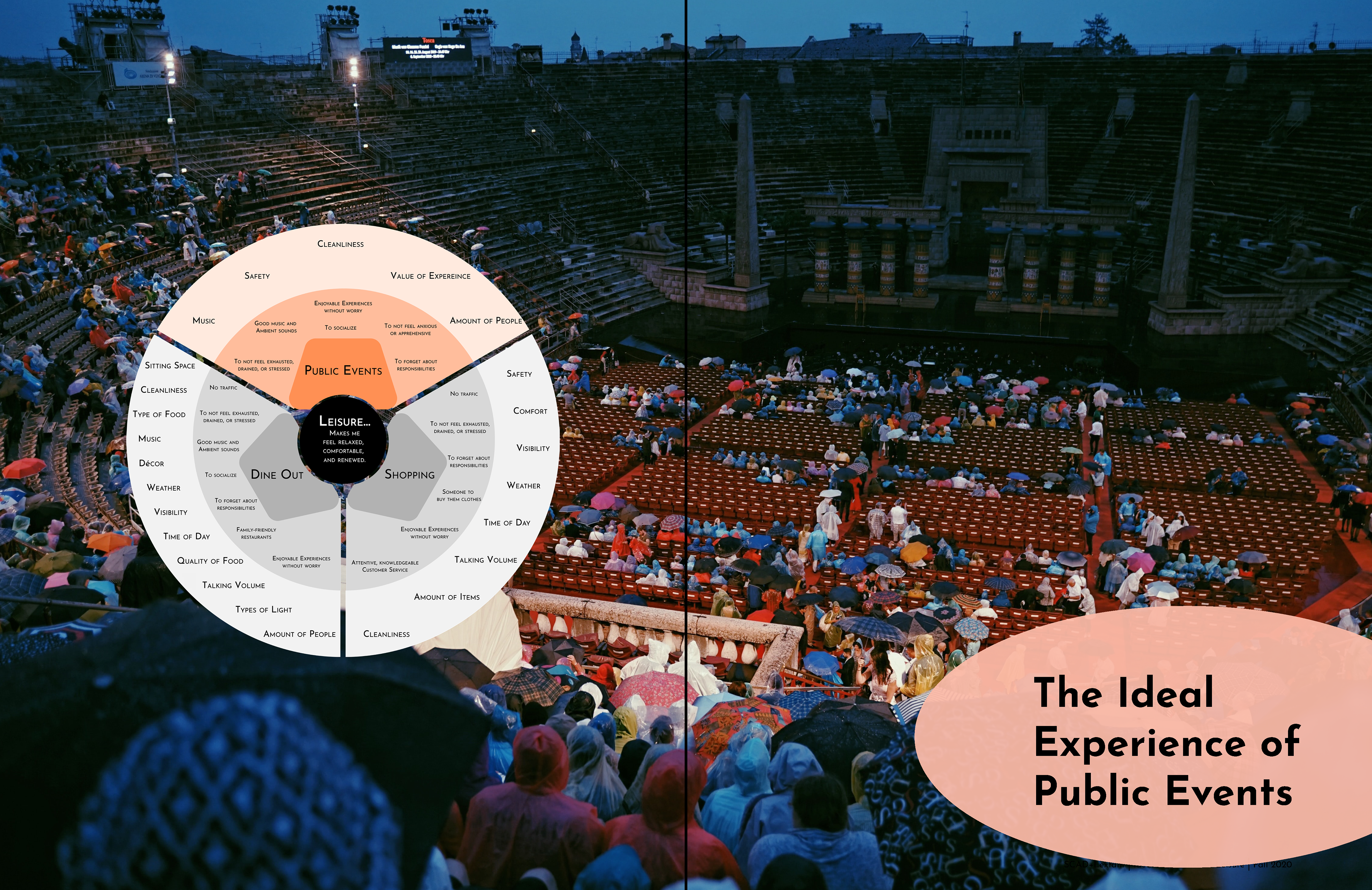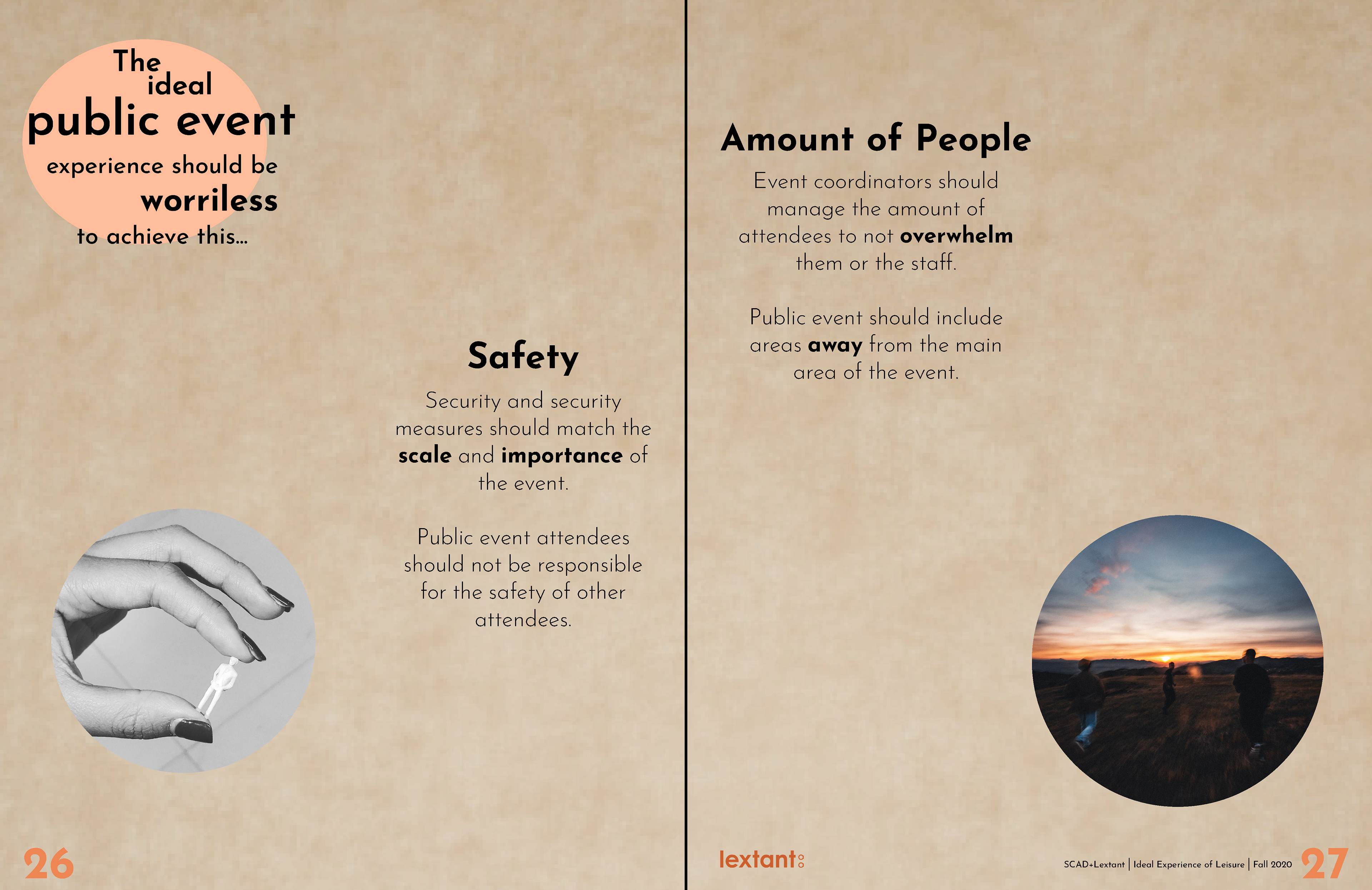The Ideal Experience of Leisure is a client research book compiled using the Lextent-patented research methods. Working in tandem with a team of user researchers, we conducted in-person field research, interviews, surveys, and sensory cue workshops. This led to the creation of a client book highlighting our findings concerning 'The Ideal Experience of Leisure' during the height of COVID-19.
Project Description
The world was shaken by the sudden emergence of COVID-19. The world as we knew it came to a screeching stop. But it wasn't just in regards to governments and essential workers. It also affected cities and companies that relied on the travel and leisurely expenditures of tourists to survive. This led to an entire financial pillar plummeting into the ground. But with that happening, there was a place for a new type of leisure to exist. We set out as a team to research and find out what that new norm was for the general public.
Research Goals
In a nutshell, our goal was simple: research what the general public deemed important or influential to their decisions to where to spend their time or money doing leisurely activities. Now along with that goal, there were a few questions that needed to be answered.
How do you relax in a world of uncertainty and misinformation? What made people choose certain stores or restaurants over others? What made people feel more comfortable and safe in this world where sanitation is the most important aspect of travel?
After whittling the questions down to their simplest forms with Lextent's research methods, we reached three different focuses for our research. These three focuses become the Anatomy of 'The Ideal Experience of Leisure.' Which I will go over later in the breakdown.
Process
Tools and Technology

Miro

Adobe Illustrator

Adobe InDesign

Adobe Photoshop

Google Forms
Miro
The bulk of our research was compiled and sorted through Miro. Miro was an easy collaborative space for our data to be compiled and then distributed to our particular clusters. This separation allowed for an easy shift from sticky notes to key data points.
Adobe InDesign
The entire end product was brought together in InDesign. InDesign was perfect for utilizing typography and spread layouts for a client book. One of the biggest helps was being able to make a distinct base design for all the inner spreads while leaving the title and end spreads unique.
Adobe Google Forms
This was one of the first times that I was able to use Google Forms for something more than just an RSVP or family survey. The power of being able to track analytics from participant surveys was integral for gathering our research. It was easy to analyze and disseminate the survey to get as many participants as possible.
Adobe Illustrator
Illustrator has always been my first program for making logos and diagrams. For this project, the focus was on making a readable and concise diagram that showed the key points we wanted to portray to our stakeholders. The vector graphics are perfect for clean representations.
Adobe Photoshop
Photoshop was the main program when it came to compiling and editing the photos used in our spreads. In addition to general edits, Photoshop was also used to create layers that became the textures found throughout the book. The minute changes that came about made a big difference in the final product.
Research Methods
There were a variety of research methods used during the length of this project. The different research methods allowed us to gather different information regards the emotions, thoughts, and reasoning of the participants. The research methods employed were as follows:
• In-Depth Interviews
• In-The-Field Observations
• Surveys
• Sensory Cue Workshops
In-Depth Interviews
The interviews consisted of a list of questions that were asked to an interviewee. Since leisure is not based on one particular area or building, the questions were geared toward the common areas people go to relax.
The main locations asked about were...
• Indoor Malls
• Grocery Stores
• Outdoor Shopping Areas
• Restaurants
• Coffee Shops.
A focus on specific preferences over common areas would skew the results and give more information about the individual but less usable data in the long run.

Kyle Pessagno - Mall and Outdoor Shopping Interview Answers

Kyle Pessagno - Dining and Coffee Shop Interview Answers

Daniel Rivera - Mall and Outdoor Shopping Interview Answers

Daniel Rivera - Dining and Coffee Shop Interview Answers
In-The-Field Observations
Each researcher volunteered for a different common area to observe the public. The spreading of the research allowed for each researcher to become an expert in their area. This helped with interviews and finding ways to represent our findings in presentations and stakeholder meetings.
The information gathered was anything that could be of use to us or our stakeholders. The main takeaways from the research were gender, clothing worn, interactions between people, and rules being observed. These set us up to make small realizations based on numerical data gained. From these realizations, we were able to gain insight into how people were handling pandemic regulations and adapting to them.

Observations of a mall, a store, and an open-air shopping center

Observations of a restaurant during a weekday night and weekend afternoon
Surveys
The survey that we created is focused on how a participant would feel and also quantitative data. The overall idea of the survey was to get an idea of how people relax and why they choose those places to relax. That coupled with the quantitative data surrounding frequency and time of leisurely activities allows us a sneak peek into what makes participants anxious and relaxed while having hard numbers to base our ideas and research on.
We surveyed 50 people of varying ages, occupations, and socio-economic backgrounds. This spread allows us to get a key lens to look through regarding the general public.

Ideal Experience of Leisure Survey - Part 1

Ideal Experience of Leisure Survey - Part 2

Ideal Experience of Leisure Survey - Part 3
Sensory Cue Workshops
Sensory cue workshops are useful because they give more than just quantitative details about how participants feel. That feeling allows for the research to transcend a lot of the guesswork associated with quantitative data. Sensory cues are key to delivering messages by viscerally communicating what consumers desire in these products, which leads to the “moment of truth” when shoppers become customers. We wanted to draw upon those visceral reactions to find how people react to common places to relax.
We utilized photos, sounds, word association, and color association to delve into each participant's preferences and beliefs. This allowed us to avoid closed-ended responses and generalized answers. With the combination of the associations and media, we ascertained information more efficiently.

Sensory Cue Workshop: Color and Emotion Focus

Sensory Cue Workshop: Participant's Preferences
Affinity Map
The vast amount of quantitative and qualitative data can be daunting. The hard work of going around and gathering all of the information is done. So what do we do next with all of this information? How do we make it work for us? The answer is simple: an affinity map.
An affinity map allows all data to be seen at one time. And from looking at each data point, they can be grouped and clustered. After being clustered, the team could decide what information was pertinent to our research goals and what was irrelevant. This condensing and extreme breakdown of each data point is tedious and time-consuming. But it is also a vital part of analyzing and categorizing information to be used in findings.
In this case, we had over 400 data points to go through. Only about one-fourth of the data points were deemed in line with our research goals. And each cluster created found its way into the Anatomy of 'The Ideal Experience of Leisure.'

Affinity Map: Clusters

Affinity Map: Cut Observations and Information
Anatomy of 'The Ideal Experience of Leisure'
With the extensive amount of observations, surveys, and research, we settled on three distinct segments to show our findings. This separation allowed our team of researchers to portray an accurate depiction of what was important to participants and the public at large. The three distinct segments were...
• "I want to go..."
• "I want..."
• "...matters to me."
"I want to go..."
These insights highlight where participants feel are leisurely activities that they most often want to partake in. These activities boil down into three activities: Shopping, Dining Out, and Public Events.
"I want..."
These insights highlight exactly why participants go out to do specific leisurely activities. The bulk of the emotional, physical, and psychological reasoning surrounding the enjoyment of said activities is consolidated here.
"...matters to me."
These insights highlight what participants wanted during their leisure time in order to be the most relaxed and safe. Each activity (Shopping, Dining Out, and Public Events) explored has a different set of criteria to make the experience ideal.
Final Thoughts and Findings
The findings from our research were simple but focused. Most of the highlights of the research were focused on how the clientele felt would make them the most relaxed in particular leisurely pastimes. In addition to the clientele's emotional responses, we also highlight what they physically wanted as well. I'll briefly break down our findings in relation to the activity associated with the findings.
For the Ideal Shopping Experience, we need it to be relaxing.
Comfort
Stores should present their business as a common brand. Customers will avoid stores that seem too classy. Staff should be knowledgeable, easily available, and kind to the customers. Franchise stores should keep the department layout of all their stores cohesive to prevent confusion.
Location
Customers shop most often at the stores they are closest to. Stores should be located closest to their clientele. The store should be located in an area that's considered safe by the public. Customers will avoid a business they usually trust if they do not trust the surrounding area.
For the Ideal Shopping Experience, we need it to be worriless.
Time of Day
Businesses should expand their hours of operation. Small windows of business hours make shoppers stressed. Shoppers will choose to shop late at night or early in the morning to avoid interference and crowds.
Selection of Items
Products should be restocked often. Customers expect certain products to be high quality and fresh (meats, cheeses, etc.) Stores should include options for customers with dietary restrictions. The store should be a "one-stop shop" for customers' needs. Customers shopping as a chore do not want to travel to multiple stores.
For the Ideal Dining Experience, we need a positive atmosphere.
Seating Arrangement
Restaurants should have indoor seating, outdoor seating, and a bar area. Restaurants should offer both tables and booths.
"If I'm doing work, I'll sit indoors. If I'm relaxing, I'll sit outdoors."
Décor
Restaurants should match their décor to the clientele and their reason for being there. Restaurants should also consider interior design, music, lighting, and aesthetics. Interior colors should be warm tones that make guests feel comfortable.
"I consider the atmosphere as the most important decision maker when dining out."
For the Ideal Dining Experience, we need it to be worriless.
Cleanliness
Restaurants should keep every aspect of their business sanitary and presentable. Guests will begin critiquing the environment as early as the entrance of the building. Staff is expected to keep the floor swept, tables wiped, dishes and utensils spotless, and the food to be presented nicely.
Quality of Food
The food is considered the most important criterion for dining. The kitchen is expected to always be sanitary and use fresh ingredients. Kitchens should offer options for those with dietary restrictions.
For the Ideal Public Event Experience, we need it to be valuable.
Music
Music events should host a variety of different artists with different sounds. Coordinators should try to host local performers as well as more popular ones.
"My favorite part was just walking around and hearing some random band and just listening. The music draws you in."
Value of Experience
Public events should provide basic necessities for the attendees. Events should positively reflect the cost of attending. Events should honor customer commitment and uphold their own.
For the Ideal Public Event Experience, we need it to be worriless.
Safety
Security and security measures should match the scale and importance of an event. Public event attendees should not be responsible for the safety of other attendees.
Amount of People
Event coordinators should manage the amount of attendees to not overwhelm them or the staff. Public events should include areas away from the main area of the event.
Final Product

The Ideal Experience of Leisure: Front Cover

The Ideal Experience of Leisure: About the Study

The Ideal Experience of Leisure: Table of Contents

The Ideal Experience of Leisure: Research Overview

The Ideal Experience of Leisure: Anatomy of the Ideal Experience of Leisure

The Ideal Experience of Leisure: Shopping

The Ideal Experience of Leisure: Shopping - Comfort/Location

The Ideal Experience of Leisure: Shopping - Time of Day/Selection of Items

The Ideal Experience of Leisure: Dining Out

The Ideal Experience of Leisure: Dining Out - Seating Arrangement/Décor

The Ideal Experience of Leisure: Dining Out - Cleanliness/Quality of Food

The Ideal Experience of Leisure: Public Events

The Ideal Experience of Leisure: Public Events - Music/Value of Experience

The Ideal Experience of Leisure: Public Events - Safety/Amount of People

The Ideal Experience of Leisure: Process

The Ideal Experience of Leisure: Observations and Surveys

The Ideal Experience of Leisure: Interviews and Sensory Cue Workshop


